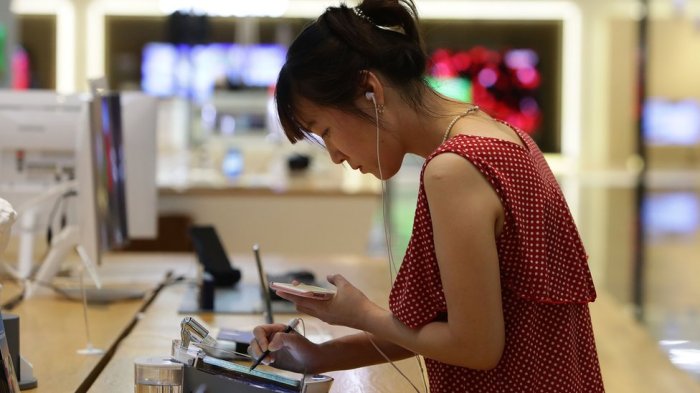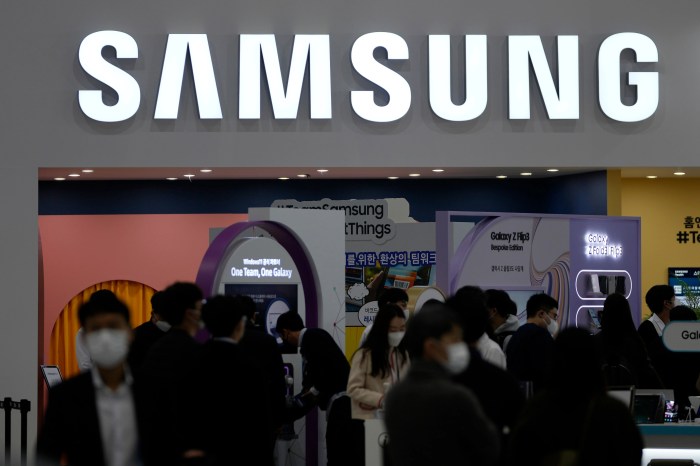Samsung’s Marketing Strategy in 2013
In 2013, Samsung’s marketing strategy in South Korea was a comprehensive approach aimed at solidifying its position as a leading technology brand and maximizing its market share. This strategy involved a multifaceted approach that leveraged various marketing channels and tactics to engage consumers, build brand loyalty, and drive sales.
Marketing Channels and Tactics
Samsung’s marketing strategy in South Korea in 2013 involved a mix of traditional and digital marketing channels, tailored to the specific preferences and behaviors of the South Korean consumer market.
- Television Advertising: Samsung heavily invested in television advertising, utilizing prime-time slots and innovative ad formats to capture the attention of viewers. This strategy aimed to create strong brand recall and associate Samsung products with premium quality and technological advancement.
- Print Media: Samsung also leveraged print media, particularly magazines and newspapers, to reach a wider audience. These advertisements often featured high-quality visuals and detailed product descriptions, emphasizing Samsung’s technological prowess and design aesthetics.
- Online Marketing: Samsung embraced digital marketing channels, including search engine optimization (), social media marketing, and online display advertising. This strategy aimed to reach target audiences online, engage them with relevant content, and drive traffic to Samsung’s online platforms.
- Experiential Marketing: Samsung organized various experiential marketing events, such as product launches, exhibitions, and consumer experiences, to create a tangible connection with its products and brand. These events aimed to foster positive brand associations and create memorable experiences for consumers.
- Celebrity Endorsements: Samsung utilized celebrity endorsements to enhance brand visibility and appeal to specific target demographics. Popular Korean celebrities, known for their style and influence, were featured in Samsung advertisements and campaigns, associating the brand with trendsetting and aspirational qualities.
Rationale for Heavy Marketing Investment
Samsung’s decision to invest heavily in marketing in its home market was driven by several key factors.
- Market Competition: The South Korean market was highly competitive, with local and international brands vying for market share. Samsung recognized the need to invest in marketing to differentiate itself from competitors and maintain its leading position.
- Brand Building: Samsung’s heavy marketing investment aimed to solidify its brand image as a leading innovator and technology provider. This strategy involved creating strong brand associations with quality, design, and technological advancement.
- Consumer Engagement: Samsung’s marketing strategy aimed to engage consumers on an emotional level, fostering brand loyalty and creating a strong sense of community among Samsung users. This approach involved creating compelling content, engaging with consumers on social media, and organizing interactive events.
- Sales Growth: Samsung’s marketing efforts were ultimately aimed at driving sales growth in its home market. By creating a strong brand presence, engaging consumers, and showcasing its latest products and technologies, Samsung sought to increase its market share and revenue.
The Role of Marketing Expenditures
Samsung’s astronomical marketing expenditures in 2013 were a strategic decision aimed at solidifying its position as a leading technology brand, not only in South Korea but globally. This aggressive approach had a significant impact on the company’s brand awareness and market share, ultimately contributing to its overall business performance.
Samsung’s massive marketing investments played a crucial role in enhancing its brand awareness and market share in South Korea. The company’s extensive advertising campaigns, encompassing television, print, and online platforms, ensured a consistent presence in the minds of consumers. This high visibility translated into increased brand recognition and a positive perception of Samsung products.
- Increased Brand Recognition: Samsung’s marketing campaigns were designed to be memorable and impactful, leaving a lasting impression on consumers. This resulted in increased brand recognition, making Samsung a top-of-mind choice for consumers in South Korea.
- Positive Brand Perception: Samsung’s marketing efforts focused on highlighting the innovative features and technological advancements of its products, leading to a positive perception of the brand among consumers.
- Market Share Gains: The increased brand awareness and positive perception of Samsung products directly contributed to the company’s market share gains in South Korea. Consumers, familiar with the brand and confident in its quality, were more likely to choose Samsung products over competitors.
Contribution to Overall Business Performance
Samsung’s marketing investments in 2013 contributed significantly to the company’s overall business performance. The increased brand awareness and market share translated into higher sales and revenue. The company’s aggressive marketing strategy also helped it to maintain its competitive edge in the South Korean market, where it faced stiff competition from domestic and international rivals.
- Increased Sales and Revenue: The rise in brand awareness and market share directly resulted in increased sales and revenue for Samsung. Consumers, attracted by the brand and its products, were more likely to make purchases.
- Competitive Advantage: Samsung’s significant marketing investments enabled it to maintain its competitive edge in the South Korean market. The company’s aggressive marketing campaigns ensured its products remained top-of-mind for consumers, making it difficult for competitors to gain ground.
- Brand Loyalty: Samsung’s marketing efforts also contributed to building brand loyalty among consumers in South Korea. The consistent messaging and positive brand perception fostered trust and confidence in the brand, leading to repeat purchases.
Comparison to Competitors
In 2013, Samsung’s marketing spending significantly surpassed that of its competitors in the South Korean market. While LG, Samsung’s primary competitor, also invested heavily in marketing, Samsung’s expenditure was notably higher. This aggressive approach allowed Samsung to dominate the market, outperforming its rivals in terms of brand awareness and market share.
- Samsung’s Dominant Spending: Samsung’s marketing expenditure in 2013 far exceeded that of its competitors, including LG. This aggressive approach reflected the company’s commitment to maintaining its market leadership position.
- Impact on Market Share: Samsung’s superior marketing spending contributed to its dominant market share in South Korea. The company’s extensive campaigns ensured a wider reach and greater impact on consumers compared to its competitors.
Specific Marketing Campaigns and Initiatives: Samsungs Astronomical 2013 Marketing Expenditures On Home Turf Detailed
Samsung’s marketing efforts in South Korea in 2013 were multifaceted and strategically designed to target various demographics and promote different product lines. The company implemented a diverse range of campaigns and initiatives, each with specific objectives and target audiences. These campaigns leveraged various media platforms, including television, online channels, and public events, to maximize their impact.
The Galaxy S4 Launch Campaign
The Galaxy S4 launch campaign was a major initiative for Samsung in 2013. The campaign aimed to generate widespread excitement and demand for the new flagship smartphone. The target audience was primarily young adults and tech-savvy consumers who were eager to adopt the latest mobile technology. Samsung utilized a multi-pronged approach to promote the Galaxy S4, including:
- Pre-launch Hype: Samsung generated significant buzz around the Galaxy S4 before its official release. They teased the phone’s features through cryptic social media posts, online videos, and exclusive media events. This created anticipation and heightened interest among potential buyers.
- Celebrity Endorsements: Samsung partnered with popular Korean celebrities to endorse the Galaxy S4. These endorsements leveraged the stars’ influence and reach to connect with a wider audience, particularly younger consumers.
- Interactive Marketing: Samsung incorporated interactive elements into their campaign, allowing consumers to engage with the Galaxy S4 through virtual experiences and online contests. This approach fostered a sense of community and excitement among target consumers.
- Launch Events: Samsung held grand launch events in major cities across South Korea, featuring live demonstrations of the Galaxy S4’s capabilities and performances by popular artists. These events created a memorable experience for attendees and further amplified the campaign’s reach.
The Galaxy S4 launch campaign was highly successful in achieving its objectives. The phone experienced record-breaking sales in South Korea, exceeding Samsung’s expectations. The campaign’s effectiveness can be attributed to its well-coordinated strategy, strong branding, and successful engagement with target consumers.
The “Samsung Tomorrow” Initiative
The “Samsung Tomorrow” initiative was a long-term social responsibility program launched by Samsung in 2013. The initiative aimed to promote education and innovation among young people in South Korea. The target audience was primarily students and aspiring entrepreneurs. Samsung implemented various programs under this initiative, including:
- Samsung Innovation Museum: Samsung opened the Samsung Innovation Museum in Seoul, showcasing the history of technology and inspiring young people to pursue careers in science and engineering.
- Samsung Scholarship Program: Samsung offered scholarships to talented students pursuing studies in STEM fields, supporting their academic endeavors and encouraging them to contribute to technological advancement.
- Samsung Startup Forum: Samsung organized startup forums and competitions, providing a platform for aspiring entrepreneurs to pitch their ideas and receive mentorship from industry experts.
The “Samsung Tomorrow” initiative was a successful example of Samsung’s commitment to social responsibility and its efforts to foster innovation in South Korea. The program contributed to the development of a future generation of talented individuals who would drive technological progress in the country.
Impact on Consumers and the Market
Samsung’s massive marketing expenditures in 2013 had a significant impact on consumer perception and purchasing decisions, shaping the competitive landscape in the South Korean market and influencing the overall dynamics of the consumer electronics industry.
Consumer Perception and Purchasing Decisions
Samsung’s aggressive marketing campaigns, particularly those featuring celebrities and emphasizing innovation and design, successfully created a positive brand image among consumers. This positive perception translated into increased trust and loyalty, leading to a higher likelihood of consumers choosing Samsung products over competitors.
Competitive Landscape in the South Korean Market
In 2013, Samsung’s dominance in the South Korean market was undeniable. The company’s extensive marketing efforts played a crucial role in solidifying this position. By showcasing its products as superior in terms of features, technology, and design, Samsung effectively outshone its competitors, particularly LG Electronics.
Samsung’s marketing campaigns created a perception of innovation and superiority, making it a preferred choice for consumers in South Korea.
Influence on the Consumer Electronics Industry
Samsung’s massive marketing expenditures had a ripple effect on the consumer electronics industry in South Korea. It set a new benchmark for marketing budgets and strategies, pushing other players to increase their spending and focus on innovative campaigns. This intensified competition, ultimately benefiting consumers with more choices and lower prices.
Samsung’s marketing investments pushed the industry to innovate and offer more competitive products, benefiting consumers in the long run.
Samsungs astronomical 2013 marketing expenditures on home turf detailed – Samsung’s 2013 marketing blitz in South Korea serves as a compelling case study in how to build a brand through aggressive and strategic investment. Their campaigns weren’t just about pushing products; they were about creating a cultural dialogue, fostering brand loyalty, and ultimately shaping consumer perception. While the sheer scale of their spending was impressive, it was the execution, the creativity, and the deep understanding of their target audience that truly made the difference. Samsung’s success in 2013 is a testament to the power of a well-crafted marketing strategy, and a reminder that sometimes, the most effective way to reach your audience is to go all in.
Samsung’s 2013 marketing blitz in South Korea was legendary, a testament to their commitment to dominating the home turf. But even with astronomical expenditures, they faced challenges like network connectivity issues, a problem that still plagues some users today. Pixel mesh network issues can be a real pain, especially when you’re trying to show off your shiny new Samsung Galaxy.
It’s a reminder that even the biggest brands can struggle with technical hiccups, and sometimes, the best marketing in the world can’t fix a faulty network.
 Standi Techno News
Standi Techno News

